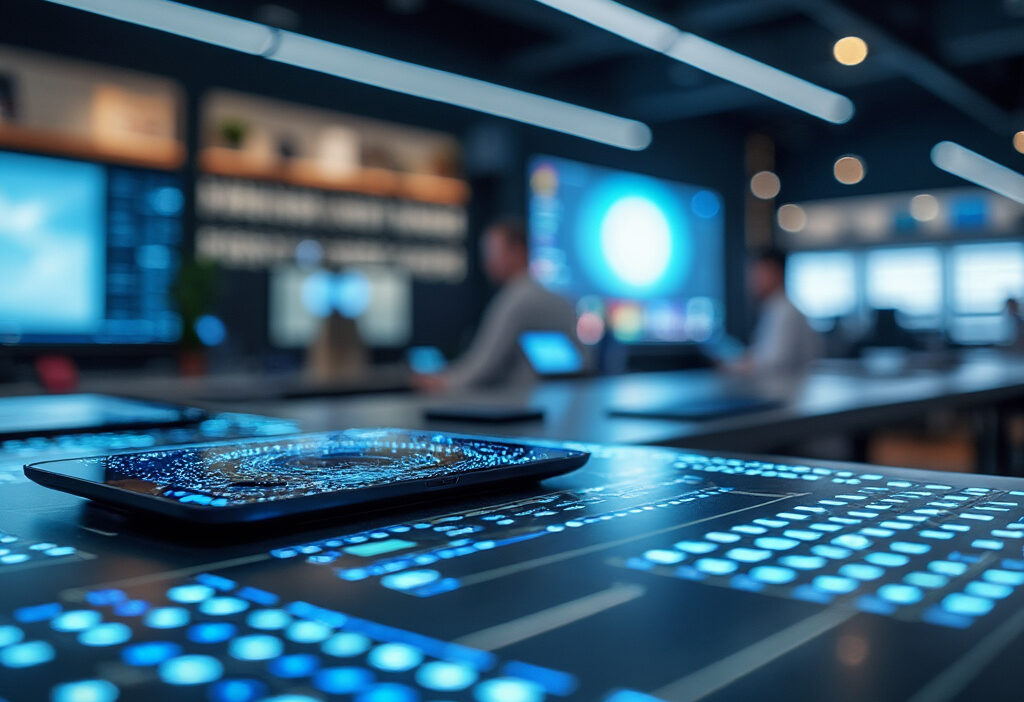Reimagining AI with io – The New Frontier by Sam Altman and Jony Ive
In a move that signifies a leap towards the future of artificial intelligence and design, Sam Altman and Jony Ive have launched ‘io’, a venture set to redefine how we interact with AI through groundbreaking hardware. This strategic fusion of Altman’s AI prowess with Ive’s design legacy aims to create devices that enhance creative possibilities and everyday use.
The Genesis of io
The genesis of io began not with a formal pitch or a business plan, but with a series of late-night conversations between Sam Altman and Jony Ive—two visionaries from seemingly disparate worlds. Altman, the AI pioneer with a relentless focus on scaling intelligence, and Ive, the design luminary who redefined how humans interact with technology, found common ground in a shared frustration: the stagnation of hardware in the AI era. Their discussions revealed a glaring gap—while AI was advancing at breakneck speed, the devices meant to harness it remained stuck in outdated paradigms.
The founding vision for io crystallized around a simple yet radical idea: AI should not just live in the cloud or behind a screen, but in objects designed to feel as natural as human intuition. Ive brought his obsession with materials, touch, and the emotional resonance of physical interactions, while Altman contributed his conviction that AI could evolve beyond chatbots and into ambient, context-aware companions. Together, they imagined a future where technology receded into the background, yet became more powerful—where devices adapted to people, not the other way around.
The mission was clear from the start: to create a new category of products that fused AI’s potential with hardware so intuitive it felt inevitable. This wasn’t about incremental upgrades or slapping AI into existing gadgets. It was about rethinking form and function from the ground up—io would be a laboratory for what happened when machine learning wasn’t just a feature, but the foundation of design itself. The name io, short yet evocative, hinted at both input/output and the mythological pursuit of something transcendent—a fitting metaphor for their ambition.
As the concept took shape, the next challenge was assembling a team capable of turning this vision into reality. The foundation was set, but the architects were yet to come.
The Architectural Dream Team
The formation of io’s core team was no accident—it was a deliberate assembly of visionaries, each handpicked by Sam Altman and Jony Ive to bring their unique expertise to the table. At the heart of this architectural dream team were Scott Cannon, Evans Hankey, and Tang Tan, whose combined talents in design, engineering, and AI laid the groundwork for io’s ambitious vision.
Scott Cannon, a former Apple designer, brought his mastery of minimalist aesthetics and user-centric design to io. His ability to translate complex AI functionalities into intuitive hardware interfaces became a cornerstone of the company’s philosophy. Evans Hankey, another Apple alum, contributed her deep understanding of materials and manufacturing, ensuring that io’s products wouldn’t just look revolutionary—they’d feel revolutionary. Her work on sustainable materials and ergonomic forms added a tangible layer of innovation to the team’s output.
Tang Tan, renowned for his engineering prowess, bridged the gap between hardware and AI. His background in integrating software with physical devices allowed io to push boundaries where others had stumbled. Under his guidance, the team developed proprietary architectures that seamlessly embedded AI into everyday objects, making the technology feel invisible yet indispensable.
Together, this trio embodied the fusion of disciplines that defined io’s approach. Their collaboration wasn’t just about stacking talent—it was about creating a synergy where design, engineering, and AI could coexist without compromise. This foundation set the stage for io’s next leap: a strategic acquisition that would amplify its reach and redefine the future of AI hardware.
io’s Strategic Acquisition
The acquisition of io by OpenAI marks a pivotal moment in the evolution of AI-integrated hardware, signaling a bold commitment to redefining how humans interact with technology. OpenAI’s decision to invest heavily in io—reportedly one of its largest strategic acquisitions—reflects not just financial backing but a profound belief in io’s vision. This move underscores the growing recognition that the future of AI isn’t confined to software alone; it demands seamless integration with thoughtfully designed hardware to unlock its full potential.
The specifics of the deal reveal a carefully orchestrated alignment of goals. OpenAI gains a world-class hardware team, while io secures the resources and AI expertise needed to accelerate its ambitious projects. The acquisition also positions io as a critical bridge between OpenAI’s cutting-edge models and the physical world, enabling innovations that could range from intuitive personal devices to transformative professional tools.
What makes this partnership particularly compelling is the shared ethos of both entities. OpenAI’s mission to ensure AI benefits all of humanity dovetails with io’s human-centric design philosophy, as championed by its core team. The investment isn’t just about capital—it’s a vote of confidence in io’s ability to deliver hardware that feels inevitable, blending AI’s capabilities with the elegance and simplicity that define great design.
This acquisition also sends a clear message to the industry: the next frontier of AI isn’t just about smarter algorithms but about creating tangible, intuitive experiences. As io’s team integrates with OpenAI, the collaboration promises to push boundaries, setting the stage for a new era where AI isn’t just something we use but something we live with. The stakes are high, but the potential rewards—reshaping how technology integrates into daily life—are even higher.
Design Philosophies and Aesthetic Vision
Jony Ive’s arrival at io marks a pivotal moment in the evolution of AI-integrated hardware. His legacy at Apple—where he redefined consumer electronics with minimalist elegance and intuitive functionality—now informs io’s design ethos. At io, Ive isn’t just shaping products; he’s crafting an entire language of interaction between humans and AI. His philosophy hinges on three core principles: simplicity, material honesty, and emotional resonance. These tenets are being applied to ensure that io’s devices feel less like tools and more like natural extensions of human intent.
One of Ive’s most significant contributions is his insistence on invisible intelligence. Unlike traditional AI gadgets that flaunt their capabilities, io’s designs will likely prioritize seamless integration. Imagine a device that anticipates needs without intrusive prompts—a concept rooted in Ive’s belief that “true innovation disappears into the experience.” This approach dovetails with Sam Altman’s vision of AI as an ambient, almost subconscious presence.
Material choices will also play a critical role. Ive’s history with aluminum, glass, and unibody construction suggests io’s hardware will marry durability with tactile warmth. Early whispers hint at sustainable materials, reflecting a broader commitment to environmental responsibility—a departure from the disposable tech culture.
Functionally, Ive is rethinking ergonomics for the AI age. Buttons, screens, and sensors won’t just be placed; they’ll be orchestrated to create fluid, instinctive interactions. This meticulous attention to detail ensures io’s products won’t just work—they’ll feel right. As the next chapter will explore, these design philosophies lay the groundwork for io’s technical ambitions, bridging aesthetics with groundbreaking engineering.
Technical Breakthroughs and Innovation
Sam Altman and Jony Ive’s io isn’t just redefining aesthetics—it’s pushing the boundaries of what AI-integrated hardware can achieve. At the core of this vision lies a radical rethinking of the operating system. Unlike traditional OS architectures, which rely on static interfaces, io is rumored to be developing a fluid, context-aware system that adapts in real-time to user behavior. Powered by advanced machine learning, it could eliminate the need for rigid app structures, instead presenting dynamic workflows tailored to individual needs.
The hardware itself is expected to blur the line between device and intelligence. Speculation suggests embedded AI co-processors in every component, enabling seamless, low-latency interactions. Imagine a device that anticipates your next task—whether drafting an email or adjusting smart home settings—before you even initiate it. Such capabilities would require breakthroughs in energy efficiency and thermal management, as always-on AI demands significant computational resources without draining battery life.
Engineering challenges abound. Integrating AI at the silicon level means rethinking chip design, possibly leveraging neuromorphic architectures to mimic human neural networks. Another hurdle is privacy: io must balance hyper-personalization with robust data security, a tension that could define its success. Early whispers hint at decentralized processing, where sensitive data remains on-device while still enabling cloud-scale intelligence.
Beyond the OS, io’s hardware could pioneer new interaction paradigms. Haptic feedback, gaze tracking, and even subvocal recognition might replace traditional touch and voice inputs. Each innovation hinges on perfecting sensor fusion—melding multiple input methods into a cohesive, intuitive experience. If successful, io won’t just compete with tech giants; it could render their paradigms obsolete.
Challenging the Tech Giants
The announcement of io isn’t just another tech venture—it’s a direct challenge to the dominance of Apple, Google, and Microsoft in consumer hardware. With Jony Ive at the helm of design, the project carries an implicit critique of the stagnation in today’s tech ecosystem. Ive’s departure from Apple was a seismic event, and his collaboration with Sam Altman signals a deliberate shift toward redefining what personal technology can be. The irony is palpable: Ive, the architect of Apple’s most iconic products, is now poised to compete against his former employer with a vision that merges AI and hardware in ways even Apple has yet to fully realize.
The implications of this rivalry extend beyond aesthetics. io’s ambition to integrate AI seamlessly into hardware—potentially bypassing traditional operating systems—threatens the walled gardens of iOS, Android, and Windows. Unlike Google’s AI-first approach or Microsoft’s enterprise focus, io appears to prioritize human-centric design, leveraging Ive’s mastery of tactile interaction and Altman’s AI expertise. This positions io not as a follower but as a disruptor, targeting the emotional connection users have with their devices—a space Apple once owned unchallenged.
The competitive landscape is further complicated by Ive’s intimate knowledge of Apple’s playbook. His insights could allow io to preemptively address weaknesses in Apple’s strategy, such as its cautious AI rollout or reliance on incremental hardware updates. Meanwhile, Google and Microsoft may face pressure to accelerate their own AI-hardware integrations, lest they cede ground to a newcomer with both design pedigree and cutting-edge technology. The stage is set for a battle where io doesn’t just compete—it forces the giants to evolve.
Market Reactions and Competitor Analysis
The announcement of io sent shockwaves through the tech industry, with immediate market reactions reflecting both excitement and uncertainty. Apple’s stock dipped by 2.3% in the hours following the news, a clear signal of investor concern over the potential disruption posed by Jony Ive’s return to hardware design—this time as a competitor. Analysts noted that the drop wasn’t just about Ive’s involvement but also the broader implications of io’s AI-integrated hardware vision, which threatens to redefine user expectations in ways that could erode Apple’s dominance in premium devices. Meanwhile, Google and Microsoft saw marginal gains, likely as investors bet on their AI-first strategies to counterbalance io’s ambitions.
Competitors are already scrambling to assess the threat. Apple, in particular, faces a delicate balancing act—how to respond without appearing reactive. Sources suggest internal teams are accelerating work on “post-touch” interfaces and deeper AI integrations, areas where io is expected to lead. Meanwhile, Google’s hardware division, known for its experimental approach, may double down on AI-driven wearables, while Microsoft could leverage its enterprise stronghold to push AI-hardware hybrids in productivity niches. Startups in the AI space, however, face a tougher road; venture capital interest may shift toward io-aligned innovations, squeezing funding for smaller players.
The most telling reaction, though, came from supply chain insiders. Reports indicate surging inquiries about io’s manufacturing partners, suggesting rivals are dissecting every possible clue about its launch timeline and capabilities. If io delivers on its promise of seamless AI-hardware synergy, the competitive landscape won’t just shift—it could fracture, forcing incumbents into a race they didn’t see coming. The next moves from Apple and others will reveal whether they’re playing catch-up or redefining the game themselves.
Future Product Roadmap
The unveiling of io marks the beginning of a carefully orchestrated rollout, with Sam Altman and Jony Ive hinting at a multi-year roadmap that will redefine AI-hardware integration. Industry insiders speculate that the first io device—likely a sleek, voice-first assistant with adaptive AI—will debut within 12 to 18 months, followed by a family of interconnected products. Early adopters can expect a three-phase evolution:
- Phase 1 (2025-2026): A standalone, minimalist device focused on ambient computing, blending into home and workspace environments while learning user behavior. The challenge? Proving its utility beyond existing smart speakers and avoiding the “gimmick” label.
- Phase 2 (2027-2028): Expansion into wearable and spatial computing, with AI that anticipates needs contextually—think real-time language translation glasses or a health-monitoring pendant. Battery life and privacy concerns will be critical hurdles.
- Phase 3 (2029+): A fully integrated ecosystem where io devices communicate seamlessly, acting as a unified AI “nervous system” for users. This phase could challenge Apple’s walled garden and Google’s fragmented AI approach.
The debut product’s success hinges on its ability to demonstrate tangible AI value—not just novelty. Unlike chatbots or static assistants, io must show proactive, personalized utility without overstepping privacy boundaries. Competitors will scramble to replicate its design ethos, but Altman and Ive’s focus on emotional resonance—hardware that feels less like a tool and more like an extension of human intent—could set a new benchmark.
Looking ahead, io’s roadmap suggests a future where AI isn’t just reactive but intuitively collaborative, reshaping how we interact with technology at a foundational level. The ripple effects could extend far beyond hardware, influencing AI ethics, developer ecosystems, and even regulatory frameworks.
The Societal Impact of io
The introduction of io’s AI-integrated hardware marks a pivotal moment in how society interacts with technology. By embedding artificial intelligence into everyday devices, io has the potential to redefine human-machine relationships, shifting them from transactional to deeply collaborative. Imagine a world where your phone doesn’t just respond to commands but anticipates needs, where your home adjusts not just to your preferences but to your emotional state, and where creative tools don’t just assist but co-create. The societal implications of such a shift are profound.
Everyday interactions with technology could become more intuitive, reducing friction in tasks that currently demand attention. AI-driven personal assistants might evolve into true digital companions, capable of nuanced understanding and proactive support. This could democratize access to advanced tools, enabling individuals with limited technical expertise to harness AI for complex tasks—whether it’s designing a presentation, composing music, or managing a household.
On a broader scale, io’s approach could reshape creativity and productivity. By blending AI with elegant hardware, the line between human and machine input may blur, fostering new forms of expression. Artists might collaborate with AI to explore uncharted styles, while professionals could offload repetitive tasks to focus on innovation. However, this raises questions about dependency and agency—will humans remain the drivers of creativity, or will AI begin to steer the process?
The societal impact extends to work and education. If io’s devices make AI assistance ubiquitous, traditional roles could transform, emphasizing adaptability over rote skills. Schools might prioritize critical thinking and emotional intelligence, preparing students for a world where machines handle the mundane. Yet, this transition won’t be seamless—issues like privacy, algorithmic bias, and digital divides must be addressed to ensure io’s vision benefits all, not just a privileged few.
As io’s products integrate deeper into daily life, society will grapple with these shifts, balancing the allure of convenience with the need to preserve human autonomy. The journey has only just begun.
Navigating the Future with io
Navigating the future with io requires a vision that extends beyond incremental improvements—it demands a redefinition of how AI and hardware coalesce to shape human experience. The long-term potential of io lies in its ability to blur the boundaries between digital intelligence and physical interaction, creating devices that don’t just respond to commands but anticipate needs and adapt seamlessly to human behavior. However, this ambition is not without challenges.
One critical hurdle is achieving true contextual awareness. For io to succeed, its AI must understand nuances in real-time environments—distinguishing between a casual conversation and a focused work session, for example. This demands breakthroughs in sensor fusion, edge computing, and privacy-preserving algorithms. Another challenge is scaling personalization without sacrificing performance. As io devices learn from individual users, they must balance bespoke experiences with universal reliability—a technical tightrope that could define their adoption.
The opportunities, though, are transformative. If io succeeds, it could catalyze a new era of ambient computing, where AI-enhanced hardware fades into the background, becoming an invisible yet indispensable partner in daily life. This would push competitors to rethink their approaches, accelerating innovation across the industry. Moreover, io’s emphasis on human-centric design could shift AI development away from pure data-driven models toward systems that prioritize empathy and intuition.
The convergence of hardware and AI through io may also redefine creative workflows. Imagine designers collaborating with AI that not only suggests ideas but physically manifests them through adaptive interfaces. The ripple effects could extend to education, healthcare, and beyond, making technology feel less like a tool and more like an extension of human capability. The road ahead is complex, but the destination—a future where technology understands us as deeply as we understand it—is worth the journey.

Conclusions
With ‘io’, Sam Altman and Jony Ive embark on a pioneering journey to merge AI with transcendent hardware design. At its heart, io aims to redefine our engagement with technology, promising a future where AI-enabled devices become extensions of human creativity and innovation. As the world anticipates its first product, the blend of Altman’s AI insight and Ive’s design genius signals a transformative shift awaiting the tech landscape.



